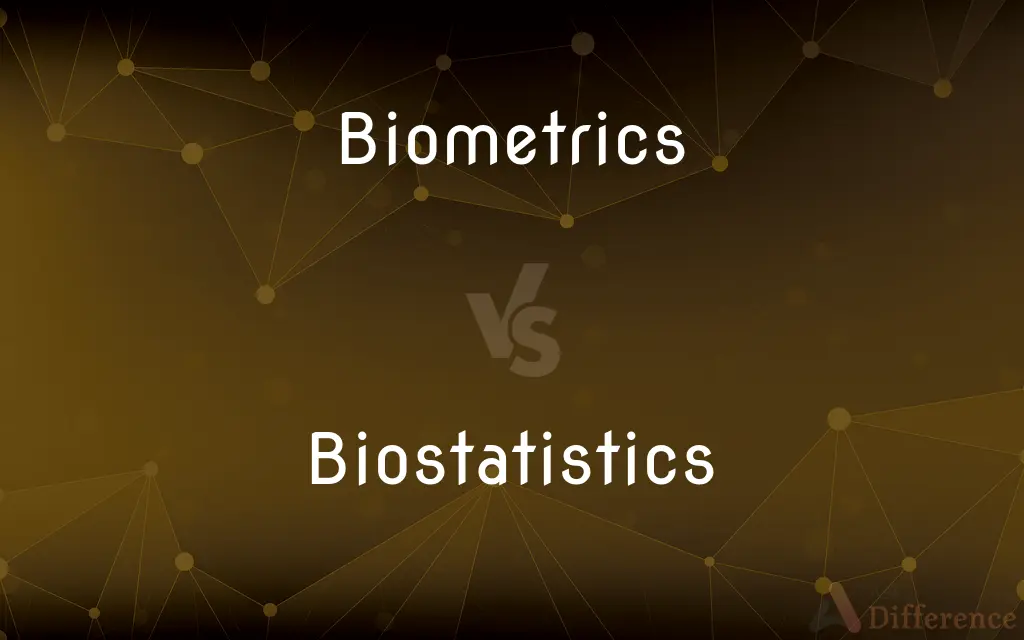Biometrics vs. Biostatistics — What's the Difference?
By Maham Liaqat & Fiza Rafique — Updated on March 22, 2024
Biometrics involves the measurement of physical and behavioral characteristics for identification, while biostatistics applies statistical methods to biological data analysis.

Difference Between Biometrics and Biostatistics
Table of Contents
ADVERTISEMENT
Key Differences
Biometrics is a technology-driven field focusing on identifying individuals based on unique physical or behavioral traits, such as fingerprints, facial recognition, or voice patterns. In contrast, biostatistics is a discipline at the intersection of biology and statistics, focusing on the collection, analysis, interpretation, and presentation of biological data.
While biometrics primarily serves the purpose of identification and security, ensuring that access to sensitive information or locations is restricted to authorized individuals, biostatistics plays a crucial role in advancing medical knowledge and public health policies. Biostatistics provides the tools necessary for understanding complex biological phenomena through data, thus informing decision-making in healthcare and research settings. On the other hand, biometrics is applied to enhance the security and efficiency of identification processes, from unlocking smartphones to border control measures.
The methodologies employed in biometrics and biostatistics also differ significantly. Biometrics relies on hardware and software to capture, store, and analyze physical or behavioral characteristics, utilizing algorithms to match these characteristics against stored data for identification purposes. Conversely, biostatistics uses statistical theories and models to analyze biological data, employing methods like hypothesis testing, regression analysis, and survival analysis to interpret data from studies and experiments in the biological and health sciences.
In terms of application, biometrics is widely used in law enforcement, border security, corporate security, and personal device authentication. It provides a convenient and secure method of identification and access control, reducing the reliance on traditional methods like passwords or ID cards. Biostatistics, whereas, is applied in a variety of scientific research areas, including clinical trials, epidemiological studies, genetics, and ecology, among others. The insights gained from biostatistical analysis inform policy decisions, medical guidelines, and scientific understanding of biological processes.
The ethical considerations surrounding biometrics and biostatistics also highlight a significant difference between the two fields. Biometrics raises privacy and ethical concerns, as the collection and use of personal biometric data must be carefully managed to protect individual rights and prevent misuse. In contrast, biostatistics faces ethical issues related to the design and conduct of research studies, including informed consent, data confidentiality, and the use of statistical methods to ensure accurate and unbiased results.
ADVERTISEMENT
Comparison Chart
Focus
Identification based on physical or behavioral traits
Statistical analysis of biological data
Purpose
Security and personal identification
Advancement of medical and biological knowledge
Methodology
Utilizes technology for data capture and analysis
Employs statistical models and theories
Applications
Security systems, personal devices, law enforcement
Medical research, public health, genetics
Ethical Considerations
Privacy and data protection
Research integrity, confidentiality, informed consent
Compare with Definitions
Biometrics
Involves both physical and behavioral characteristics.
Voice recognition systems authenticate users through unique vocal patterns.
Biostatistics
Contributes to policy decisions and medical guidelines.
Analysis of health data informs government health policies.
Biometrics
Used extensively in security and access control.
Biometric passports contain digital images for border security.
Biostatistics
Applies statistical methods to biological data analysis.
Biostatisticians analyze clinical trial data to assess drug efficacy.
Biometrics
Enhances the convenience and security of identification processes.
Biometric systems at airports expedite passenger verification.
Biostatistics
Involves designing experiments and interpreting results.
A biostatistician designs a study to test a new vaccine's effectiveness.
Biometrics
Technology for identifying individuals based on unique traits.
Fingerprint scanners on smartphones use biometrics for security.
Biostatistics
Faces ethical considerations in research.
Ensuring patient data confidentiality is a major concern in biostatistical studies.
Biometrics
Raises privacy and ethical questions.
The use of facial recognition in public spaces has sparked privacy concerns.
Biostatistics
Essential in medical research and public health.
Biostatistics helps track and predict disease outbreaks.
Biometrics
Biometrics are body measurements and calculations related to human characteristics. Biometric authentication (or realistic authentication) is used in computer science as a form of identification and access control.
Biostatistics
Biostatistics (also known as biometry) are the development and application of statistical methods to a wide range of topics in biology. It encompasses the design of biological experiments, the collection and analysis of data from those experiments and the interpretation of the results.
Biometrics
The statistical study of biological phenomena.
Biostatistics
The branch of statistics that deals with data relating to living organisms.
Biometrics
The measurement of physical characteristics, such as fingerprints, DNA, or retinal patterns, for use in verifying the identity of individuals.
Biostatistics
Application of statistics to the analysis of biological and medical data.
Biometrics
The automated measurement of biological data.
Biostatistics
The application of statistics to the study and analysis of biological and medical data
Biometrics
The automated recognition of individuals based on their behavioural and biological characteristics.
Biostatistics
Plural of biostatistic
Biometrics
A branch of biology that studies biological phenomena and observations by means of statistical analysis
Biostatistics
Vital statistics.
Common Curiosities
What is biometrics primarily used for?
Biometrics is used for identification and security, utilizing unique physical or behavioral characteristics of individuals.
Are there privacy concerns with biometrics?
Yes, the collection and use of biometric data raise privacy concerns, necessitating careful management to protect individual rights.
What role do biostatisticians play in clinical trials?
Biostatisticians design clinical trials, analyze data, and interpret results to assess the safety and efficacy of new medical treatments.
What ethical issues are associated with biostatistics?
Ethical issues include ensuring informed consent, maintaining confidentiality of data, and using appropriate statistical methods to produce accurate, unbiased results.
How does biostatistics benefit public health?
Biostatistics analyzes health data to inform public health policies, disease control measures, and medical research, improving health outcomes.
How do biostatistics and biometrics intersect?
While primarily distinct, both fields can intersect in areas like healthcare, where biometric data is used for patient identification and monitoring, and analyzed statistically for research and treatment purposes.
How do biostatistics impact healthcare decisions?
Biostatistical analysis of medical data supports evidence-based healthcare decisions, influencing treatment guidelines and policy making.
What makes biometrics unique in identification processes?
The use of inherent physical or behavioral traits in biometrics provides a unique, difficult-to-falsify method for secure identification and access control.
Can biometrics identify individuals with high accuracy?
Yes, biometrics can accurately identify individuals based on unique traits, such as fingerprints or facial features, making it highly effective for security purposes.
Can biometrics replace traditional security measures?
Biometrics can complement or replace traditional security measures, like passwords, due to its convenience and the difficulty of replicating biometric traits.
Share Your Discovery

Previous Comparison
Punishment vs. Sentence
Next Comparison
Atonement vs. PenanceAuthor Spotlight
Written by
Maham LiaqatCo-written by
Fiza RafiqueFiza Rafique is a skilled content writer at AskDifference.com, where she meticulously refines and enhances written pieces. Drawing from her vast editorial expertise, Fiza ensures clarity, accuracy, and precision in every article. Passionate about language, she continually seeks to elevate the quality of content for readers worldwide.













































